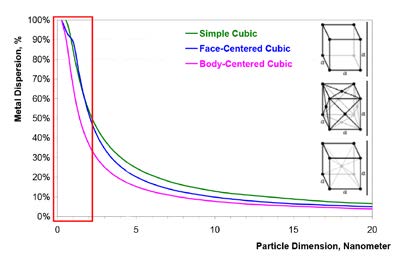Tech Briefs
Savannah River National Laboratory
Highly Dispersed Metal Catalyst
Scientists at The Savannah River National Laboratory (SRNL) have developed a platinum catalyst material that exhibits higher dispersion qualities than catalysts used in commercial fuel cells. Better dispersion translates into improved activity indicating new active sites and/or reducing the precious metal usage. A metal dispersion of 1.00 is defined as that 100% of the metal atoms are available for catalysis. Values less than 1.00 may indicate crystallite growth or a surface interference. Even as small as 3 to 4 nm particles, only 25-35% of the Pt is active in catalysis, since only that fraction of the Pt atoms is accessible. The recent development of highly dispersed metal catalyst at the atomic level has demonstrated the achievement of 100% Platinum dispersion on carbon-based support and verified the catalyst activity for quantitative conversion of hydrogen and oxygen into water at ambient condition. Further, the catalyst is more active than the availability of Pt, increasing the catalyst activity by magnitudes, or reducing the precious metal usage by the same factor. The highly dispersed Platinum catalyst was robust under repeated service and high temperature cycles.
Fuel cell electrocatalysts frequently employ 20-50 wt% platinum (Pt) while less than 0.5 wt% Pt is needed when 100% dispersed. If every platinum atom is active for catalytic reaction rather than stacked over each other catalyst activity would increase while reducing precious metal usage. SRNL Scientists have developed the method for full dispersion of active metals into a high surface area of support to promote efficiency.
Background
A metal dispersion of 1.00 is defined as that 100% of the metal atoms are available for catalysis. Values less than 1.00 may indicate crystallite growth or a surface interference. Even as small as 3 to 4 nm particles, only 25-35% of the Pt is active in catalysis, since only that fraction of the Pt atoms is accessible. The recent development of highly dispersed metal catalyst at the atomic level has demonstrated the achievement of 100% Platinum dispersion on carbon-based support and verified the catalyst activity for quantitative conversion of hydrogen and oxygen into water at ambient condition. Further, the catalyst is more active than the availability of Pt, increasing the catalyst activity by magnitudes, or reducing the precious metal usage by the same factor. The highly dispersed Platinum catalyst was robust under repeated service and high temperature cycles.

At a glance
- Atomic level dispersion
- Catalytic activity higher than availability of Pt
- Ultimately efficient
- Minimum Pt needed
- U.S. Patents 10,322,405 B2 and 9,486,786 B2
Partnering opportunities
SRNL invites interested companies with proven capabilities in this area of expertise to enter into a licensing agreement with SRNL to market this nuclear material detection system. Interested companies will be requested to submit a business plan setting forth company qualifications, strategies, activities, and milestones for commercializing this invention.
Qualifications should include past experience at bringing similar products to market, reasonable schedule for product launch, sufficient manufacturing capacity, established distribution networks, and evidence of sufficient financial resources for product development and launch.
Download Tech Brief
Contact Information
Savannah River National Laboratory
E-mail: partnerships@srnl.doe.gov